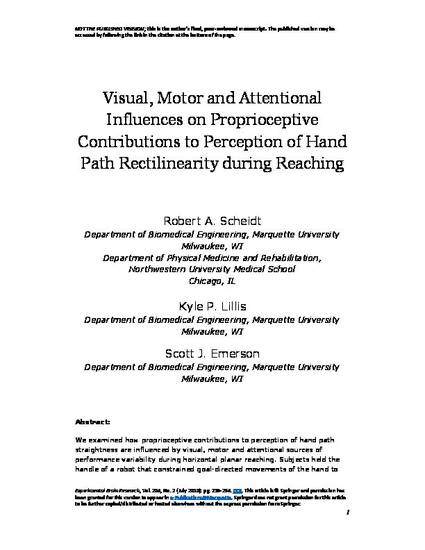
We examined how proprioceptive contributions to perception of hand path straightness are influenced by visual, motor and attentional sources of performance variability during horizontal planar reaching. Subjects held the handle of a robot that constrained goal-directed movements of the hand to the paths of controlled curvature. Subjects attempted to detect the presence of hand path curvature during both active (subject driven) and passive (robot driven) movements that either required active muscle force production or not. Subjects were less able to discriminate curved from straight paths when actively reaching for a target versus when the robot moved their hand through the same curved paths. This effect was especially evident during robot-driven movements requiring concurrent activation of lengthening but not shortening muscles. Subjects were less likely to report curvature and were more variable in reporting when movements appeared straight in a novel “visual channel” condition previously shown to block adaptive updating of motor commands in response to deviations from a straight-line hand path. Similarly, compromised performance was obtained when subjects simultaneously performed a distracting secondary task (key pressing with the contralateral hand). The effects compounded when these last two treatments were combined. It is concluded that environmental, intrinsic and attentional factors all impact the ability to detect deviations from a rectilinear hand path during goal-directed movement by decreasing proprioceptive contributions to limb state estimation. In contrast, response variability increased only in experimental conditions thought to impose additional attentional demands on the observer. Implications of these results for perception and other sensorimotor behaviors are discussed.
Available at: http://works.bepress.com/robert_scheidt/23/
Accepted version. Experimental Brain Research, Vol. 204, No. 2 (July 2010): 239-254. DOI. © 2010 Springer. Used with permission.
Shareable Link. Provided by the Springer Nature SharedIt content-sharing initiative.